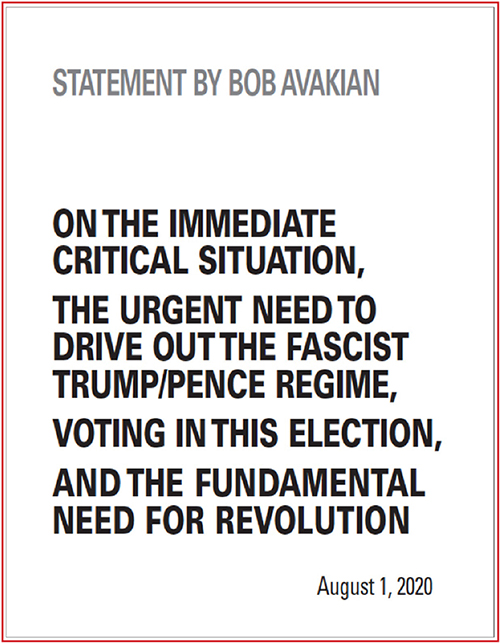What Happens When a Fascist Leader Is Re-Elected?
A Flashing Red Warning Sign from India
| revcom.us
Editors’ Note: This week, we are bringing to our readers the following article about developments with the fascist regime in India headed by Narendra Modi. This experience (and others, such as with Recep Erdoğan in Turkey) illustrates how fascism takes a leap either through an election “mandate” or freedom seized by fascists out of necessity—and the serious implications of this for the masses of people. Although what we face with the Trump/Pence regime is not identical, the example of India helps illustrate the reality that if Trump is able to come through the next months and declare “victory”—whether through an election win, a delayed or canceled vote, or some other way—that will not simply be a matter of things getting somewhat worse. It will be a leap—a definite leap toward consolidation of fascist rule in the U.S. Thus, as Bob Avakian states in his recent statement, “Right now, for everyone who is concerned with ending injustice and oppression, and with the question of whether humanity will have a future worth living—or will have a future at all—removing the Trump/Pence fascist regime from power is an immediate, urgent question and truly historic imperative.” (Read the whole statement, ON THE IMMEDIATE CRITICAL SITUATION, THE URGENT NEED TO DRIVE OUT THE FASCIST TRUMP/PENCE REGIME, VOTING IN THIS ELECTION, AND THE FUNDAMENTAL NEED FOR REVOLUTION.)
In May of 2019, Narendra Modi was reelected as prime minister. A coalition of parties led by Modi’s BJP won 44% of the vote, trouncing a coalition led by the Indian Congress Party (the main ruling class party since India’s founding), which got only 25%.
This victory empowered and emboldened Modi’s regime to accelerate the Hindu-fascist transformation of India, which began with Modi’s first election in 2014.1
Modi has always been an open Hindu supremacist, but during his 2014 campaign and through part of his first term he downplayed this in favor of “carefully moderated public positions … in line with his projected image as a pro-development leader and global statesman.” Modi sought to reassure “minority groups” that India remained a multi-national and secular society. And he implemented some popular reforms, including building a hundred million toilets in a country in which lack of sanitation is a source of widespread disease and humiliation.
Simultaneously Modi moved to consolidate power throughout Indian society, getting control of the courts and most mass media, and appointing Hindu nationalists to leading positions in universities and the government—BJP figures who took the lead in promoting open and virulent racism against Muslims and other minorities.
Modi appointed Amit Shah, the president of BJP, as Home Minister. Shah regularly referred to Muslims as “termites” who BJP would “throw into the Bay of Bengal.” He also appointed, Yogi Adityanath, a Hindu priest, as chief minister of Uttar Pradesh, India’s largest state. Adityanath was jailed in 2007 for inciting anti-Muslim riots, after a speech in which he threatened, “If one Hindu girl marries a Muslim man, then we will take 100 Muslim girls in return ... If they [Muslims] kill one Hindu man, then we will kill 100 Muslim men.” He publicly defended a Hindu mob that killed a Muslim man suspected of slaughtering a cow (cows are sacred in Hinduism) and suggested that the murdered man’s family should be prosecuted instead. (He has also praised Trump’s ban on Muslim immigration!)
This in turn unleashed BJP activists to carry out attacks on Muslims for such crimes as herding cattle. Dozens were killed and hundreds injured in these attacks during Modi’s first term; BJP leaders responded by saying things like “We will hang those who kill cows,” and “I will break the hands and legs of those who do not consider cows their mother and kill them.”
The BJP also waged a broad ideological campaign to literally rewrite the history of India to extol the “greatness” of Hinduism and its alleged persecution by Muslims. They even went so far as to insist that Hindus were using airplanes, stem-cell research and the Internet in 1000 A.D.! And as renowned Indian historian Romila Thapar pointed out, the Hindu nationalist version of reality “has the patronage of the government, is well financed, and is popularized in a variety of ways. Those critical of this Hindutva history are already being labeled anti-national in an attempt to subvert historical research.”
But all of this, terrible as it was, was only a prelude to what the Modi regime would do once he was reelected in 2019 and could claim a “mandate” for fascism. Fifteen months later, an Indian commentator described the results as a “systematic and ruthless action toward rewriting the constitution and ushering in a new grammar of state power.” The New York Times reported that “Critics are deeply worried that Mr. Modi is trying to wrench India away from its secular, democratic roots and turn this nation of 1.3 billion people into a religious state, a homeland for Hindus. ‘They want a theocratic state,’’ said B.N. Srikrishna, a former judge on India’s Supreme Court.”
Here are four examples of Modi’s post-reelection fascist offensive:
Invasion and occupation of Jammu and Kashmir: Jammu and Kashmir is the sole Muslim-majority state in India. Under India’s constitution (Article 370) it is guaranteed full autonomy, except for matters of defense and security.
On August 5, 2019, without warning Modi abrogated (violated) Article 370 and invaded. Revcom.us described what happened next:
August 5 Kashmir woke up caged. Every home was turned into a jail with a statewide curfew.… Over five hundred Kashmiri politicians were jailed and thousands more arrested in one swoop. Any spontaneous protest was crushed with an iron fist, and people were beaten, maimed, jailed and killed mercilessly. …young boys, 10 to 13 years old, were kidnapped and abducted from families in night raids by Indian forces, and are being held in jails without charges… Kashmiri jails are full, the children are now taken to jails of other states. The aim is clear—to eliminate Muslims from Kashmir, perform an ethnic cleansing, and change its demographics forever.
India also completely shut down the Internet in Kashmir for five months, as well as barring all foreign journalists. A year later, heavy repression continues.
New “Citizenship Law” Threatens Muslim Population with Loss of Rights, Deportation—or Concentration Camps: In August 2019, in the state of Assam, the government initiated a process compelling everyone to produce documentary proof that they or their ancestors were born in India prior to 1971, or lose their citizenship. Under this law a person of immigrant heritage who was born in India 58 years ago could lose their citizenship. Two million Assamese “failed the test.”
This process was openly aimed at finding undocumented immigrants from Bangladesh, India’s predominantly Muslim neighbor, millions of whom fled to India during Bangladesh’s War of Independence from Pakistan in 1971. This new citizenship test unleashed great fear among Muslims, which only grew as “foreign tribunals” were thrown together to “judge” citizenship and detention camps built for the newly-created “non-citizens”—at least 10 camps are planned. (India has no treaty under which it can deport people to Bangladesh, so “non-citizens” of Bangladeshi heritage are subject to indefinite detention.) Dozens of people committed suicide, including a 14-year-old girl.
On November 19, 2019, the BJP Home Minister announced in parliament that it would go nationwide with the hunt for Muslim “illegals.” Then, to make the anti-Muslim character of this completely clear, on December 11, 2019, BJP passed a law providing Hindu, Christian and Buddhist immigrants—but not Muslims—a path to citizenship. A human rights activist got to the heart of what BJP was doing: “Muslims are the enemy. It’s a war on the Indian Constitution.”
(Go here and here for more on the citizenship laws.)
Police Brutality and Unleashing Pogroms to Suppress Protests: Protests erupted against the new citizenship laws, starting among Hindu students in Assam but quickly spreading to all faiths and across the country. The government responded with the same savage brutality as in Kashmir, shooting one Christian protester to death, teargassing students in a library, and surrounding and beating protesting Muslims in New Delhi. A nine-year-old boy riding his bicycle was crushed in a stampede of people fleeing police attack. The Internet was shut down, curfews were imposed. On January 30, a gunman opened fire on protesters in the capital city of Delhi, wounding one student, as police stood by and casually watched.
According to the New York Times, although the traditional ruling class opposition parties were “fractured” and on the sidelines, the defiance of the protesters posed “a threat to [Modi’s] ideological agenda.” The Times quotes a professor in the city of Varanasi: “I’m hearing it all over town: People are fed up with this regime.” The protests continued to spread in the face of severe repression until at least late February. For the first time since his election, the Times noted, Modi was on the defensive.
Then on February 23, 2020, Kapil Mishra, a local BHP politician, called a counter-protest against mostly women demonstrators who were blocking a road in Delhi. According to the Times, he gave “a fiery speech in which he issued an ultimatum to the police: either clear out the demonstrators, who were blocking a main road, or he and his followers would do it themselves. Within hours, the worst Hindu-Muslim violence in India in years was exploding. Gangs of Hindus and Muslims fought each other with swords and bats, shops burst into flames, chunks of bricks sailed through the air, and mobs rained blows on cornered men.”
By the time it was over, at least 46 people were dead and terror gripped Muslims in the capital. Not long after, Modi locked down all of India in a disastrous response to the coronavirus pandemic. At least for a time, the “threat” of people of different religions uniting to oppose Hindu-fascism had been quelled.
Building a Hindu Temple on the Ruins of a Mosque Destroyed by Hindu Nationalists: In November of 2019, in a mark of the growing subservience of India’s judicial system to the Hindu-fascist regime, the Supreme Court ruled that Hindus could build a temple at the site of a destroyed mosque in Ayodhya. Muslims had built a mosque there in the 16th century. Hindu nationalists—claiming that it was on the birth-site of the Hindu god Rama—destroyed it in 1992, setting off religious violence that killed 2,000 people. Ever since the fascists have wanted to build a Hindu temple there.
Modi chose August 5, 2020—the first anniversary of his invasion of Kashmir—to offer “holy water” and to set the ceremonial cornerstone for the new temple, declaring, “The wait of centuries is coming to an end”!
According to the Times, this was “an unmistakable milestone in [Modi’s] efforts to shift India’s secular foundations toward a more overtly Hindu identity” and “another decisive step toward an India that officially favors its Hindu majority.” And they quote another expert saying it “symbolized Mr. Modi’s ‘total domination over India.’”
So, “What Happens When a Fascist Leader Is Re-elected?”
Shashi Tharoor, a liberal politician says Modi “delegitimised dissent and criticism as hostile to the national interest, and every liberal thought and contrarian idea as undermining national pride and unity.” And Tharoor quotes political scientist Suhas Palshikar saying Modi “formalised the peripheralisation of the Muslims both spatially and politically, while the celebrations openly involving state machinery underscore the officialisation of the status of Hindu religion as the basis of the new republic.”
Or to put it simply, when fascists are allowed to remain in power, they use their power to implement fascism—in his case a Hindu-fascist theocratic state.
Does any of this seem familiar?
1. India is a country of 1.3 billion people. 80 percent are Hindu, 14 percent—200 million—are Muslim, and there are many other religious minorities, including Christians, Sikhs, and Buddhists.
The area that is now India and Pakistan was colonized by Britain for hundreds of years. The British used contradictions between Muslims and Hindus to maintain their own domination. When they were forced out of the region in 1948, they divided it into India—predominantly Hindu—and Pakistan—predominantly Muslim—as a way to weaken the newly independent countries and keep the region under imperialist control. That partition process set off sectarian violence in which hundreds of thousands were killed.
The founding Constitution of India established it as secular (not based in religion) and non-sectarian (not favoring any religious group over another.) But within this legal framework, reactionary forces have continued to stoke religious differences to gain power and to weaken and oppress the masses, and bloody outbreaks of religious violence spatter across India’s history. This is also bound up with contention between India and Pakistan to be the dominant power in the South Asian region, and with the machinations of various imperialist powers backing one or the other (or both) of them.
The Bharatiya Janata Party (the BJP), led by Prime Minister Narendra Modi, is a Hindu fascist party. Similar to the Christian fascists in the U.S., BJP’s objective is to transform India into a Hindu country, period. As one India scholar put it: “He sees himself as the architect of a new India, built on a foundation of technological, cultural, economic and military prowess, and backed by an ideology of Hindu nationalism.” This can only be done by violently oppressing Muslims and other minorities, suppressing dissent, and discarding or ignoring the existing Constitution. [back]
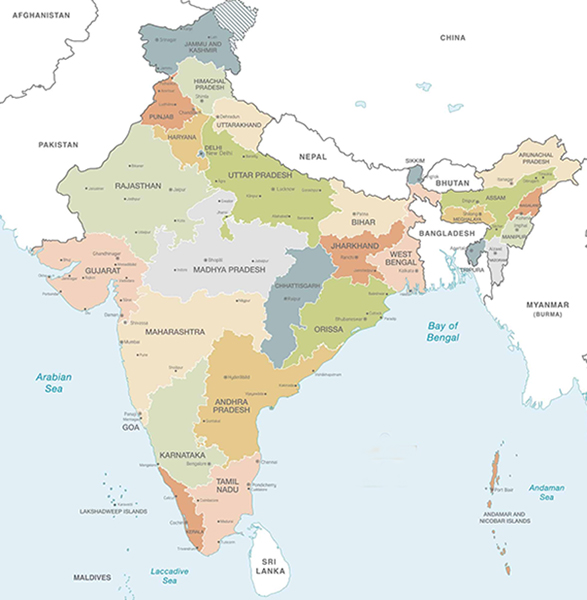
Map of India
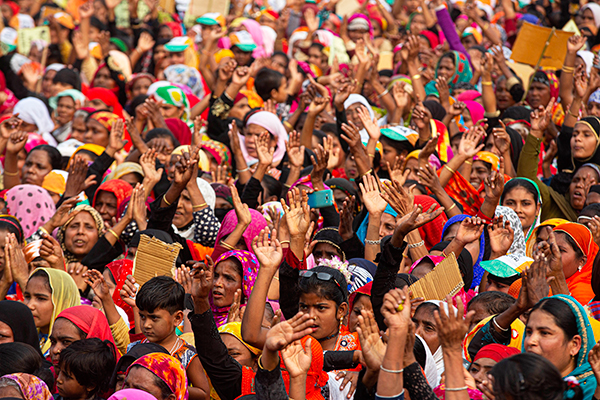
Protests erupted against the new immigration law, starting among Hindu students in Assam but quickly spreading to all faiths and across the country. (Photo: AP)
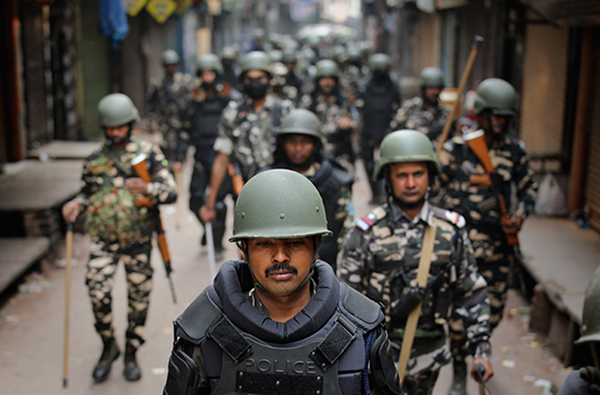
The government responded with savage brutality against protests. (Photo: AP)
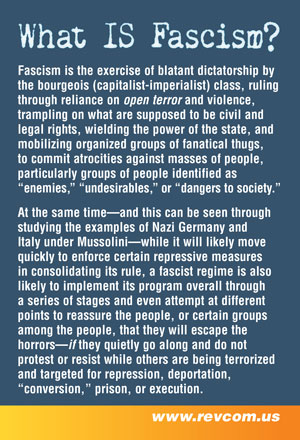
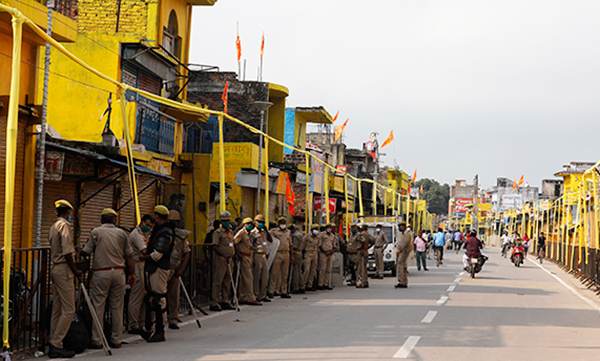
On August 5, 2020—the first anniversary of the invasion of Kashmir—Modi offered “holy water” to set the ceremonial cornerstone of the new temple, shifting India's foundations toward a more Hindu identity. Police guard the scene. (Photo: AP)
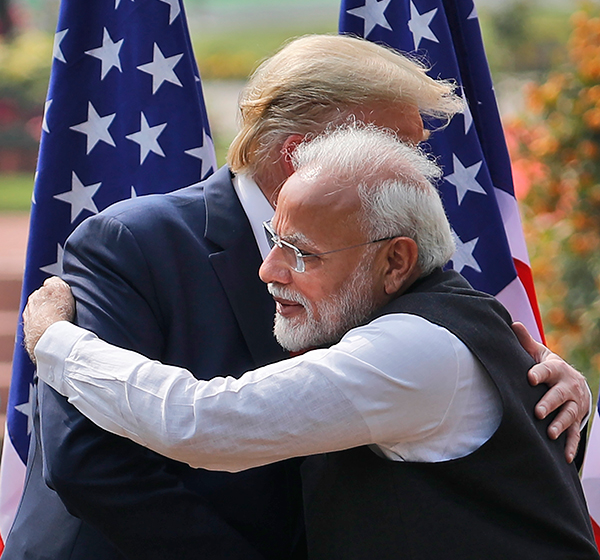
Trump visited India in February 2020. The two fascists, Trump and Modi, embraced.
Get a free email subscription to revcom.us:


